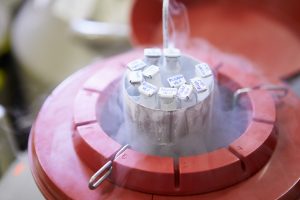
Disclaimer: I attended and presented at this meeting, as discussed in the column. The views expressed are mine alone.
Sperm and egg banks have helped countless families obtain that missing piece to conceive a child. But fertility treatment practices have faced growing criticism, especially from those most affected: donor-conceived persons. Many are now fierce advocates for the rights of those conceived using donor eggs, sperm, or embryos. On October 20 and 21, 2022, a first-of-its-kind meeting was held in Los Angeles, California, to bring together stakeholders to address the rising call for regulation of fertility practices.

[E-BOOK] 5 AI Productivity Hacks To Save Time And Streamline Your Law Firm
Discover five practical ways to harness AI and eliminate busywork—so you can focus more on your clients and less on repetitive tasks.
Changing Times
In May 2022, Colorado was the first state to pass wide-ranging legislation aimed at protecting donor-conceived persons. The Donor-Conceived Persons and Families of Donor-Conceived Persons Protection Act becomes fully effective on January 1, 2025, and requires all gamete (egg and sperm) banks, fertility clinics, and gamete-matching agencies practicing in Colorado, or working with Colorado residents, to be licensed by Colorado, and to abide by a strict set of regulations. Among those regulations are the requirements that:
- all recipients and donors receive educational material on the needs and interests of donor conceived persons
- donors be over the age of 21
- donors agree to the release of their identifying information to donor-conceived offspring at 18
- the gametes of any single donor not be used to establish more than 25 families (with no limit on the number of children born within each family)
- gamete banks, fertility clinics, and gamete-matching agencies maintain records indefinitely
The U.S. Donor Conceived Council, a nonprofit formed to increase awareness and promote the needs and interests of donor-conceived persons, was a lead advocate on the Colorado bill.
The Colorado law was a wake-up call for many stakeholders in the area of assisted reproductive technology. It signified the growing voice of donor-conceived persons affected by fertility practices. The October meeting provided an opportunity for the concerns of donor-conceived persons to be voiced directly to leaders in the area and for constructive dialogue.
The Meeting
The meeting was coordinated by California Cryobank/Donor Egg Bank USA and Fairfax Cryobank/Fairfax Eggbank, two of the largest gamete banks in the United States; the U.S. Donor Conceived Council; and RESOLVE: The National Infertility Association. Industry professionals, mental health experts, lawyers, professors, and the donor-conceived community were invited. Included among the large turnout was a founding member of Donor Conceived Australia, traveling all the way to Los Angeles to attend in person.
Donor Conceived Trauma And Experiences
The gathering kicked off Thursday evening with donor-conceived persons telling their personal stories. Among the varied experiences shared were those of late-discovery — finding out (often through a commercial DNA test) later in life that a person believed to be a genetic parent, was, in fact, not. For some, this discovery also included information that their racial or ethnic identity was substantially different than they had been told. Some reached out to the donor or donor’s family and made positive connections; others were met with rejection. Some described health conditions, and later learning that the donor or donor siblings also suffered from the same genetically linked conditions.
Especially poignant among the powerful personal accounts was that of a donor-conceived person with LGBTQ+ parents describing her experience of knowing from an early age that she was donor conceived, but later discovering a large number of half-siblings through a commercial DNA test. She described being close to, and appreciating the relationship she has with several of her half-siblings, but also the trauma she felt as the number of siblings overwhelmingly ballooned — and even today seems to be without end. Other stories included donor-conceived persons connecting with donors and other genetic relatives — some described finding what felt like a missing piece of themselves — and establishing meaningful familial relationships.
Looking For Common Ground
The U.S. Donor Conceived Council presented the results of a survey of close to 500 donor-conceived persons, donors, and recipient parents. On several topics, respondents were mostly in agreement — such as support for the release of a donor’s identity to a donor-conceived person before the age of 18, and limiting the number of families using a given donor’s gametes to a maximum of about 10. Other areas of the survey revealed more of a split, such as whether a registry of donors should be operated by the industry or the government (as is the case in several other countries).
The second day of the meeting focused on three main topic areas: donor-identity disclosure, donor-eligibility criteria, and family-unit limits. Each topic area included presentations from a gamete bank representative, two mental health professionals, and two attorneys.
Donor Identity Disclosure
Although not every donor-conceived person may want or choose to know the person responsible for half of their genetic makeup, there is clear consensus among the donor-conceived community that every donor-conceived person should have the option of accessing that information if they wish to. The question of timing, however, raised a number of issues. Legal representatives for the LGBTQ+ community expressed concerns that in states where laws were less protective of single parents and LGBTQ+ parents, the release of identity before the age of 18 could create increased legal risk to parents, donors, and the donor conceived. Donor-conceived advocates pointed out that despite the legal risk, many single and LGBTQ+ parents are already using DNA tests to connect with their donors, believing it to be in the best interest of their children.
Another complication was raised with respect to fertility laws in other countries. For example, in Israel a parent-to-be is not permitted to use a known donor’s gametes unless the donor agrees they will parent the child. Such laws clash with traditional known-donor arrangements.
Donor Eligibility Criteria
The question of who should be permitted to be a donor raised especially sensitive issues. While a criminal background check may be considered a basic precaution by some, it also raised issues of race discrimination, based on the disparate impact such checks could have. Moreover, disqualifications of donors in various categories raised concerns of eugenics. The donor-conceived advocates did not endorse specific genetic screening or disqualifications, but advocated for the results of any genetic testing and collected family medical history to be provided to recipient parents and donor-conceived offspring.
Family Unit Limits
I attended the meeting and spoke on this topic, particularly as to the concern of legislated family limits, subject to civil penalties, that may be difficult to calculate. While there was consensus that the number of families using a single donor should be limited, the exact limit and how that number should be tracked and counted raised issues. I discussed a provision in the Colorado law requiring counting for family-unit limit purposes to include “industry best practices, including methods or processes to account for the number or percentage of live births that are likely not reported, such as the correlation between the number of units of donor gametes sold or released and the resulting live births.” While some gamete banks already limit vials based on ratios they calculate to correlate to live births, other banks, especially smaller ones, may lack statistically significant data to make meaningful calculations. Looking to other countries that impose limits is not particularly helpful, as those countries invariably have a national registry for such tracking purposes.
The Hosts
The meeting was held at the headquarters of California Cryobank. As a large sperm and egg bank, California Cryobank has been included as a target of criticism by donor-conceived persons. Despite that natural friction, representatives were receptive to hearing the concerns of donor-conceived advocates. They also described how many of the practices have changed and been updated over the years, including medical and psychological screening of donors, some banks requiring all “open ID” donation (donor to be known at 18), and self-limiting the number of recipients using the same donor’s gametes (although generally at a much higher number than desired by many donor-conceived people and parents). The host and other sperm banks listened and provided responses to the questions, and also explained their own obstacles and struggles to find donors to meet the growing demand, especially of single parents by choice and LGBTQ+ families.
Jaime Shamonki, M.D., a California Cryobank and Donor Egg Bank USA representative, explained that the gamete banks work to optimize physical and mental health outcomes for donor-conceived people, but the natural consequence of rigorous screening and mandatory identity disclosure means only 0.5% of applicants currently become donors. “Banks are already challenged to achieve the high standards we’ve set for donor qualifications while meeting a growing demand by the families who rely on third-party donation for conception. We appreciate the legislative efforts that seek to protect donor-conceived people, however our community must be mindful that legislation doesn’t further restrict access to safe gamete donation. An unintended and negative consequence to this reduced access may lead to increase in use of unregulated sperm donor sources, which would have an overall negative effect on donor conceived people.” An increase in the use of unregulated sperm donor sources likely would mean more sperm kings like this serial donor we interviewed on my podcast.
What’s Next?
Colorado’s law is expected to be only the start of a movement toward more regulation. But, in the meantime, self-regulation and improved practices by professionals and businesses in the fertility space are positive steps forward. Moreover, the potential for collaboration — or at least helpful feedback — from a diverse group of stakeholders will make for better-informed future regulation, if it occurs.
 Ellen Trachman is the Managing Attorney of Trachman Law Center, LLC, a Denver-based law firm specializing in assisted reproductive technology law, and co-host of the podcast I Want To Put A Baby In You. You can reach her at [email protected].
Ellen Trachman is the Managing Attorney of Trachman Law Center, LLC, a Denver-based law firm specializing in assisted reproductive technology law, and co-host of the podcast I Want To Put A Baby In You. You can reach her at [email protected].
